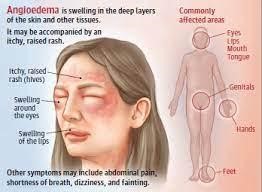A nurse is preparing to administer morphine 8 mg IV intermittent bolus to a client. The amount available is morphine 10 mg/mL. How many mL should the nurse administer?
(Round the answer to the nearest tenth. Use a leading zero if it applies. Do not use a trailing zero.)
The Correct Answer is ["0.8"]
To calculate the amount of morphine to administer, we can use the following formula:
Amount of medication (mL) = Desired dose (mg) / Concentration (mg/mL)
In this case, the desired dose is 8 mg and the concentration is 10 mg/mL.
Amount of medication (mL) = 8 mg / 10 mg/mL
Amount of medication (mL) = 0.8 mL
Therefore, the nurse should administer 0.8 mL of morphine.
Nursing Test Bank
Naxlex Comprehensive Predictor Exams
Related Questions
Correct Answer is C
Explanation
The nurse should expect angioedema as one of the manifestations of anaphylaxis in a client experiencing an allergic reaction to an antibiotic. Angioedema is a severe swelling that occurs beneath the skin, typically affecting the face, lips, tongue, throat, or other body parts. It is a result of the release of histamine and other inflammatory mediators in response to the allergen.
Anaphylaxis is a life-threatening allergic reaction that can occur rapidly and affect multiple body systems. In addition to angioedema, other common manifestations of anaphylaxis include:
-
Difficulty breathing or wheezing due to bronchospasm
-
Hives or urticaria, which are itchy raised skin rashes
-
Severe itching or tingling sensation
-
Rapid and weak pulse
-
Low blood pressure leading to hypotension
-
Nausea, vomiting, or diarrhea
-
Feeling of impending doom or anxiety
Let's go through the other options:
A. Hypertonic reflexes: This is not a manifestation of anaphylaxis. "Hypertonic reflexes" are not typically associated with allergic reactions or anaphylaxis. Hypertonic reflexes refer to increased muscle tone, but they are not part of the usual presentation of anaphylaxis.
B. Increase in systolic blood pressure: Anaphylaxis usually leads to a decrease in blood pressure rather than an increase. The decrease in blood pressure can be severe and result in shock, which is a life-threatening condition.
D. Urinary retention: Urinary retention is not a common manifestation of anaphylaxis. Anaphylaxis primarily affects the respiratory and circulatory systems, leading to airway constriction, difficulty breathing, and cardiovascular collapse. Urinary retention is not directly related to the pathophysiology of anaphylaxis.

Correct Answer is ["0.8"]
Explanation
To calculate the amount of morphine to administer, we can use the following formula:
Amount of medication (mL) = Desired dose (mg) / Concentration (mg/mL)
In this case, the desired dose is 8 mg and the concentration is 10 mg/mL.
Amount of medication (mL) = 8 mg / 10 mg/mL
Amount of medication (mL) = 0.8 mL
Therefore, the nurse should administer 0.8 mL of morphine.
Whether you are a student looking to ace your exams or a practicing nurse seeking to enhance your expertise , our nursing education contents will empower you with the confidence and competence to make a difference in the lives of patients and become a respected leader in the healthcare field.
Visit Naxlex, invest in your future and unlock endless possibilities with our unparalleled nursing education contents today
Report Wrong Answer on the Current Question
Do you disagree with the answer? If yes, what is your expected answer? Explain.
Kindly be descriptive with the issue you are facing.
